| Ever wondered what life would be without water? It has been noted in history that the first civilizations which flourished in the world had one thing in common – they were all located near rivers or deltas. Yes, water was a significant contributor to their existence.
Today, water is a significant factor in the development of communities. With regards to growth and development, the presence of a viable water source plays a vital role in the identification of whether a community is progressive or not. Several determining factors of development is directly associated to water. This is why people clamor to have access to potable water system in their communities. Often times, for communities who do not have direct access to water, they will prioritize having their water woes addressed if given the chance to rank their needs. Kalahi-CIDSS in Las Nieves 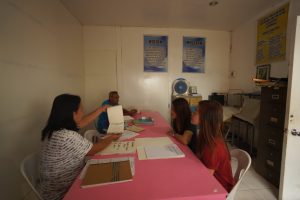 Las Nieves, Agusan del Norte was among the first municipalities in Caraga to implement the Kapit-Bisig Laban sa Kahirapan – Comprehensive and Integrated Delivery of Social Services (Kalahi-CIDSS) project. It was in 2004 that the project was piloted during the Kalahi-CIDSS – KKB implementation. Since it was still a new project to the municipality, which explains the community’s hesitation about having to participate in the implementation. As the days went by, the people began to understand features of the program. Activity after activity, they began to realize that it was a decent project that might address their needs. During the Participatory Situational Analysis (PSA), it was the first time that they were able to see the uniqueness of the Kalahi-CIDSS; their voices were heard, they were asked about the community problems that hindered their progress. This was unlike any of the programs or services from the government. One of the most active barangays implementing the project was Barangay Poblacion, headed by their dynamic Barangay Chairperson, Reinario Rosales (who would later on win a mayoralty seat in Las Nieves/currently a Sanguniang Bayan member). They were among the first barangays to be prioritized for a sub-project. It was a challenge for the Barangay Local Government Unit during that time. As SB Member Rosales explained: 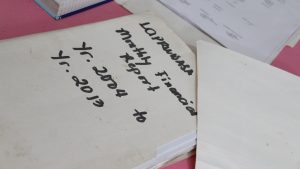 “We had difficulty looking for cash counterpart for the BLGU. We did not have available funds. We had to convince one of the residents to lend us their land title so that we could use it as collateral for a bank loan. But looking back, it was all worth it. We still enjoy the project up until now.” Prior to the entry of Kalahi-CIDSS, Poblacion already had a water system managed by the LGU. But it was already in really bad condition. There was insufficient water supply, and only households, with topstands near the water tank, would enjoy some supply that would only be available early morning up until noon time. When the Kalahi-CIDSS PSA was conducted, hands down, everyone acknowledged the fact that absence of sustainable water system was a common problem for their community; Though the water source was a good one, and was right in the heart of the Poblacion, they did not have funds to improve it to level-2, where water would be readily available through tap stands. Brgy. Poblacion was prioritized; Php 800,000 was allocated for their level-2 electric-driven water system. The LGU agreed, as part of their counterpart, the utilization of the already existing water tank to be used for the Kalahi-CIDSS project. The sub-project budget covered for the enhancement of the pipelines, additional pipes to cover still unreached households, improvement of the pump and wirings, and for the tap stands. Thirty (30) tap stands were completed which served 180 households in Barangay Poblacion during the 2004 Kalahi-CIDSS implementation. As part of the implementation, each household was to do a “pahina” or free service. Each household dug the area in front of their houses for the pipes to be buried, and they will be obligated to ensure that the pipes be kept secured and the area clean. This was the first initiative to maintain the water system in their community. For the Operation and Maintenance plan, each household was to pay a monthly fee of fifteen pesos (Php15). The amount collected would be utilized for the operation and maintenance of the sub-project, together with the allocation from the barangay local government unit. Stepping up to ensure sustainability One of the technical assistance from Kalahi-CIDSS, especially prior to the completion and the turn-over of the sub-project to the community, was the strengthening of the Operation and Maintenance (O&M) Group who will ensure that the water system would be operational and will be sustained. One of the initial plans for the community sub-project proposal was for the O&M group to be strengthened and registered. With the help of the MLGU and the BLGU, this was realized. A month before the sub-project was completed and turned over to the O&M group, they underwent a series of trainings to become a Barangay Water System Association (BAWASA). The Las Nieves Poblacion Waterworks and Sanitation Association (LAPRUWASA) was born – it was registered to serve the purpose of maintaining the Kalahi-CIDSS water system sub-project in Brgy. Poblacion. They applied and was registered by the SEC and they were registered under the Dept. of Labor and Employment. This was a good start, especially that the community really wanted to ensure sustainability of their water system sub-project. Improvement to Level – 3 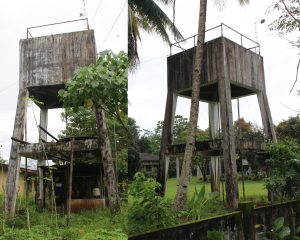 Roughly six months after the sub-project became operational, LAPRUWASA was able to acquire enough assets to expand their services. In one of the regular Barangay Assemblies for the community, several household consumers expressed their intentions to be allowed to improve their connections – they wanted to have direct access of the water services directly to their homes. This clamor from the consumers was looked into by the management. With enough funds to improve the pump and pipes, and cater the demands of the consumers plans were made by the O&M group. LAPRUWASA presented in the next barangay assembly the good news. The Kalahi-CIDSS Sub-project they managed was ready for Level-3 service. Forty percent (40%) of the consumers availed the level-3 upgrade. As per agreement, the household consumer would be the one to procure their own water-metering gadget and produce their own pipes that would connect the lines from the tap stand going to their houses. Initial agreement was that the Php15 fixed monthly fee would still be maintained for those consumers using the tap stands – eight pesos (Php8) per cubic meter will be charged to those with the level – 3 services. The rates were approved via barangay assembly, a system handed down by the Kalahi-CIDSS process. Kalahi-CIDSS believes that all decisions made for the progress and development of the community must be agreed upon by the whole community. INFORMED CONSENT is advocated by the project. This is why, the association still heeds to the voice of the assembly. LAPRUWASA operation: 2004 – 2015 LAPRUWASA was able to organize themselves to ensure that the association will be operational and will be able to serve its purpose. Every three years they choose their Board of Directors (5 BOD) who will be in-charge of running the operations and policy making for the association. But the group ensured that the assembly will still be approving everything the BOD agrees upon. All policies and plans will have to be presented, and approved by the assembly (community). Every month the BOD, together with the other members, which compose the organizational structure (treasurer, secretary, auditor, bookkeeper, collectors, meter readers, plumber, etc.) conduct a meeting. This is to discuss matters about the organization and their operational status. They conduct an assembly twice-a-year, attended by members of the community. During these assemblies, they provide rice subsidy to members as their way of giving back to consumers. Since they are on the spectrum of service to consumers, the organization ensures that they facilitate the needs of the consumers the best possible way. They clean the water tanks (2 tanks supplying Poblacion) every month, or sometimes twice if the situation calls for it. Regular chlorination/flushing of the lines is done every month to ensure that the pipes/tanks are kept clean. They also conduct sanitary inspection, coordinating with the Dept. of Health for the bi-annual (2x a month) testing of the quality of water source and that of the pipe quality. Taking on a much aggressive step towards sustainability Sometime in 2015, one of the pumps was damaged. They had to shell out a large amount to procure a new pump to replace the defective one. It was during this time that the BOD realized that there was a need to increase their charges to ensure that they will be able to operate and maintain the sub-project well. The BOD presented this notion to the assembly, and after a thorough discussion with the community, it was approved by the assembly that a two pesos increase will be reasonable. The rate was now ten pesos (Php10) per cubic meter. But even with the increase another issue came into the organization’s attention. There were reports that there were some areas where the water output has some kind of sediments. This prompted the BOD to act on the matter. Filtering devices needed to be procured and placed on the pipe lines to correct the problem. But they need to spend a hefty amount for the upgrade. In one of the technical sessions with the RPMO Kalahi-CIDSS who visited the barangay, it was suggested that it would be beneficial for the organization to come up with an alternative for their income generation. The water system in place is already a decade-old. In no time, the pumps, pipes, generators, etc., will need some upgrades. With this, the BOD proposed to the assembly that they will have to loan a certain amount of money from the LGU to put up a water-refilling station, which will serve as a secondary source of income. Fortunately, the LGU was very keen in loaning them the amount with such favorable terms. 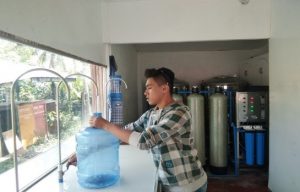 They were able to put up a water refilling station in 2016. Now, they have a secondary source of income to ensure that any operation and maintenance needs will be addressed. The water refilling station not only caters to patrons from Poblacion, but also from the other barangays. It is quite convenient on their part since they no longer pay for the water source, compared to other water refilling stations in the municipality. This way, they can sell their products in a much cheaper price. Future plans Currently, the association is preparing to expand their services to other barangays. This will be achieved with their proposed plan of adding another water tank which will ensure enough supply for the 315 households it is catering to as of the moment. Adding the new tank will allow another 50-70 households as additional consumers. As of the moment, the 315 households already have 15 households from Barangay Malicato and Tinukuran. These households have decided to acquire LAPRUWASA’s services since it is more stable than their water suppliers in the barangay. Concrete impact of Kalahi-CIDSS Las Nieves is one of the unique areas of Kalahi-CIDSS in Caraga where there is concrete evidence of the impact of the program. Since 2004, there are a handful of Kalahi-CIDSS volunteers, and Barangay Officials who have been active in the implementation who have won seats during Barangay/Municipal elections. This is because Kalahi-CIDSS has empowered community volunteers and barangay officials to rise above the challenges and molded them to be active members of the society. LAPRUWASA has been operating since 2004. Up until now, they have been very effective in maintaining and operating the Kalahi-CIDSS sub-project of Barangay Poblacion. It is amazing how community volunteers would be able to effectively organize themselves and act as one body to achieve a common purpose – and that is to promote development in their community. Kalahi-CIDSS may have given the people of Poblacion, Las Nieves, Agusan del Norte funds for their community sub-project. But it is through their bayanihan and hard work that they were able to address their needs. And it is through their common goal of maintaining their community sub-project that they have strived to ensure the sustainability of their water system sub-project.
|
Philippine Standard Time:
Archives
RECENT POSTS
LIST OF NGOS WITH FUND RAISING PERMITS
ACCREDITED CIVIL SOCIETY ORGANIZATIONS (2025)
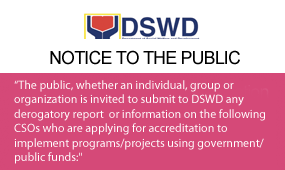
- ANTIK SUSTAINABLE LIVELIHOOD PROGRAM ASSOCIATION
- ARELLANO UNITED SUSTAINABLE LIVELIHOOD PROGRAM ASSOCIATION
- CATADMAN UNITED FISHERFOLK SUSTAINABLE LIVELIHOOD PROGRAM ASSOCIATION
- DELTA BOA SUSTAINABLE LIVELIHOOD PROGRAM ASSOCIATION
- LLAMERA ACHIEVERS SUSTAINABLE LIVELIHOOD PROGRAM ASSOCIATION
- See More

